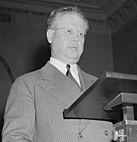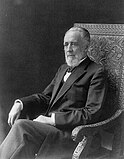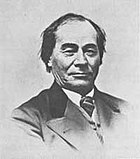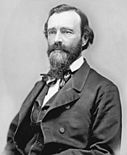Portal:Colorado/Selected biography
Use
The layout design for these subpages is at Portal:Colorado/Selected biography/Layout.
- Add a new selected biography to the next available subpage.
- The text should be approximately 60 words from the biography.
- Update
{{Random portal component|max=total|header=Selected biography|subpage=Selected biography}}on Portal:Colorado with the new selected biography total.
Colorado selected biography list
Selected biography 1
Portal:Colorado/Selected biography/1
Ralph Lawrence Carr (December 11, 1887 – September 22, 1950) was an American attorney and politician who served as the 29th Governor of Colorado from 1939 to 1943. During World War II, he defended the rights of American citizens of Japanese descent and allowed their voluntary relocation to Colorado. (Full article...)In 1938, after running unopposed in the Republican primary, Carr was elected to a two-year term as governor of Colorado, defeating Democrat Teller Ammons, the incumbent governor.[1][2]
A conservative Republican, Carr was committed to fiscal restraint in state government and opposed the New Deal policies of President Franklin Roosevelt.[3][4]
In July 1939, he joined 33 other governors is a statement calling for "moral rearmament" as a solution to the current economic crisis.[5] In August he sent the Colorado National Guard to quell violence between AFL-organized strikers and non-strikers at the Green Mountain Dam construction site.[6] In late 1939, when he was mentioned as a possible Republican candidate for vice-president on the national ticket in 1940, he indicated he preferred to seek re-election as governor: "I am not interested in any job outside Colorado right now."[7] At the Republican National Convention in June 1940, Carr supported Wendell Willkie and seconded his nomination.[8]
Selected biography 2
Portal:Colorado/Selected biography/2
Florence Rena Sabin (November 9, 1871 – October 3, 1953) was an American medical scientist. She was a pioneer for women in science; she was the first woman to hold a full professorship at Johns Hopkins School of Medicine, the first woman elected to the National Academy of Sciences, and the first woman to head a department at the Rockefeller Institute for Medical Research. During her years of retirement, she pursued a second career as a public health activist in Colorado, and in 1951 received the Albert Lasker Public Service Award for this work. (Full article...)Selected biography 3
Portal:Colorado/Selected biography/3
Zebulon Montgomery Pike (January 5, 1779 – April 27, 1813) was an American brigadier general and explorer for whom Pikes Peak in Colorado is named. As a U.S. Army officer he led two expeditions through the Louisiana Purchase territory, first in 1805–1806 to reconnoiter the upper northern reaches of the Mississippi River, and then in 1806–1807 to explore the southwest to the fringes of the northern Spanish-colonial settlements of New Mexico and Texas. Pike's expeditions coincided with other Jeffersonian expeditions, including the Lewis and Clark Expedition and the Red River Expedition in 1806.Pike's second expedition crossed the Rocky Mountains into what is now southern Colorado, which led to his capture by the Spanish colonial authorities near Santa Fe, who sent Pike and his men to Chihuahua (present-day Mexico) for interrogation. Later in 1807, Pike and some of his men were escorted by the Spanish through Texas and released near American territory in Louisiana.
In 1810, Pike published an account of his expeditions, a book so popular that it was translated into several languages for publication in Europe. He later achieved the rank of brigadier general in the American Army and served during the War of 1812 until he was killed during the Battle of York in April 1813, outside the British colonial capital of Upper Canada. (Full article...)
Selected biography 4
Portal:Colorado/Selected biography/4
Madeleine Jana Korbel Albright (born Marie Jana Körbelová, later Korbelová; May 15, 1937 – March 23, 2022) was an American diplomat and political scientist who was the first woman to serve as the U.S. Secretary of State, a post she held in the cabinet of President Bill Clinton from 1997 to 2001.Born in Prague, Czechoslovakia, Albright immigrated to the United States after the 1948 communist coup d'état when she was eleven years old. Her father, diplomat Josef Korbel, settled the family in Denver, Colorado, and she became a U.S. citizen in 1957. Albright graduated from Wellesley College in 1959 and earned a PhD from Columbia University in 1975, writing her thesis on the Prague Spring. She worked as an aide to Senator Edmund Muskie from 1976 to 1978, before serving as a staff member on the National Security Council under Zbigniew Brzezinski. She served in that position until 1981 when President Jimmy Carter left office.
After leaving the National Security Council, Albright joined the academic faculty of Georgetown University in 1982 and advised Democratic candidates regarding foreign policy. Following the 1992 presidential election, Albright helped assemble President Bill Clinton's National Security Council. She was appointed United States ambassador to the United Nations from 1993 to 1997, a position she held until her elevation as secretary of state. Secretary Albright served in that capacity until President Clinton left office in 2001. (Full article...)
Selected biography 5
Portal:Colorado/Selected biography/5
Henry Moore Teller (May 23, 1830 – February 23, 1914) was an American politician from Colorado, serving as a U.S. senator between 1876–1882 and 1885–1909, also serving as Secretary of the Interior between 1882 and 1885. He strongly opposed the Dawes Act, intended to break up communal Native American lands and force assimilation of the people, accurately stating that it was directed at forcing the Indians to give up their land so that it could be sold to white settlers. Among his most prominent achievements was authoring the Teller Amendment which definitively stated that, following the Spanish–American War, the United States would not annex Cuba, rather that the purpose of their involvement would be to help it gain independence from Spain. (Full article...)Selected biography 6
Portal:Colorado/Selected biography/6
Caroline Spencer (October 30, 1861 – September 16, 1928) was an American physician and suffragist who campaigned extensively for women's rights, both in her home state of Colorado and on the national level. She was one of many Silent Sentinels who demonstrated in front of the White House, and also participated in Watchfires, during the final months before the Nineteenth amendment was passed. She was inducted into the Colorado Women's Hall of Fame in 2006. (Full article...)Selected biography 7
Portal:Colorado/Selected biography/7
William Jackson Palmer (September 18, 1836 – March 13, 1909) was an American civil engineer and veteran of the American Civil War. During the Civil War, he was promoted to brevet brigadier general and received a Medal of Honor for his actions.In his early career, Palmer helped develop the expanding railroads of the United States in Pennsylvania; this was interrupted by the American Civil War. He served in colorful fashion as a Union Army cavalry Colonel and was appointed to the brevet grade of Brigadier General. After the war, he contributed financially to educational efforts for the freed former slaves of the South.
Heading west in 1867, Palmer helped build the Kansas Pacific Railway. He befriended a young English doctor, Dr. William Abraham Bell, who became his partner in most of his business ventures. Generally Palmer took the role of president with Bell as vice president. The two men are best known as co-founders of the Denver and Rio Grande Railroad (Rio Grande). The Rio Grande and its successors eventually operated the largest network of narrow gauge railroad in the United States. They were ultimately absorbed by the 21st century Union Pacific Railroad. (Full article...)
Selected biography 8
Portal:Colorado/Selected biography/8
Golda Meir (née Mabovitch; 3 May 1898 – 8 December 1978) was an Israeli politician who served as the fourth prime minister of Israel from 1969 to 1974. She was Israel's first and only female head of government and the first in the Middle East.Born into a Ukrainian-Jewish family in Kyiv in what was then the Russian Empire, Meir immigrated with her family to the United States in 1906. She graduated from the Milwaukee State Normal School and found work as a teacher. While in Milwaukee, she embraced the Labor Zionist movement. In 1921, Meir and her husband immigrated to Mandatory Palestine, settling in Merhavia, later becoming the kibbutz's representative to the Histadrut. In 1934, she was elevated to the executive committee of the trade union. Meir held several key roles in the Jewish Agency during and after World War II. She was a signatory of the Israeli Declaration of Independence in 1948. Meir was elected to the Knesset in 1949 and served as Labor Minister until 1956, when she was appointed Foreign Minister by Prime Minister David Ben-Gurion. She retired from the ministry in 1966 due to ill health.
In 1969, Meir assumed the role of prime minister following the death of Levi Eshkol. Early in her tenure, she made multiple diplomatic visits to western leaders to promote her vision of peace in the region. The outbreak of the Yom Kippur War in 1973 caught Israel off guard and inflicted severe early losses on the army. The resulting public anger damaged Meir's reputation and led to an inquiry into the failings. Her Alignment coalition was denied a majority in the subsequent legislative election; she resigned the following year and was succeeded as prime minister by Yitzhak Rabin. Meir died in 1978 of lymphoma and was buried on Mount Herzl. (Full article...)
Selected biography 9
Portal:Colorado/Selected biography/9
Robert Williamson Steele (January 14, 1820 – February 7, 1901) was governor of the extralegal Territory of Jefferson, which existed in the western United States from 1859 to 1861, when it was replaced by the Territory of Colorado.On September 29, 1859, Steele was nominated for Governor of the proposed Territory of Jefferson. On October 24, 1859 the formation of a provisional government was approved and Steele defeated J.H. St. Matthew for Governor.
Governor Steele opened the first session of the provisional territorial legislature on November 7, 1859, with a proclamation:
Let us then enter upon our duties with a determination of spirit that conquers all difficulties: working for the benefit of the whole commonwealth, encouraging moderation and conservation in all our acts, that we may never be ashamed of having taken an humble part of the organization of a Provisional Government for the Territory of Jefferson.
Steele called for the next session to meet on January 23, 1860.
Selected biography 10
Portal:Colorado/Selected biography/10
Clara Brown (1800–1885) was a former enslaved woman from Virginia and Kentucky who became a community leader and philanthropist. She helped formerly enslaved people become settled during Colorado's Gold Rush. She was known as the 'Angel of the Rockies' and made her mark as "Colorado's first black settler and a prosperous entrepreneur".Brown, born in Virginia in 1800, moved to Logan County, Kentucky, with her family. She married another enslaved person when she was 18 and they had four children. In 1835, Brown's family was broken apart when they were all sold to different slave owners. When Brown was 56, she received her freedom but was required by law to leave the state. She worked her way to Denver, Colorado, as a cook and laundress on a wagon train.
Brown settled in the mining town now called Central City, Colorado, where she worked as a laundress, cook, and midwife. With the money she made, she invested in properties and mines in nearby towns. Known as "Aunt Clara" for her emotional and financial support, Brown was a founding member of a Sunday school that was held in her home. (Full article...)
Selected biography 11
Portal:Colorado/Selected biography/11
William Wells Bent (May 23, 1809 – May 19, 1869) was a frontier trader and rancher in the American West, with forts in Colorado. He also acted as a mediator among the Cheyenne Nation, other Native American tribes and the expanding United States. With his brothers, Bent established a trade business along the Santa Fe Trail. In the early 1830s Bent built an adobe fort, called Bent's Fort, along the Arkansas River in present-day Colorado. Furs, horses and other goods were traded for food and other household goods by travelers along the Santa Fe trail, fur-trappers, and local Mexican and Native American people. Bent negotiated a peace among the many Plains tribes north and south of the Arkansas River, as well as between the Native American and the United States government.In 1835 Bent married Owl Woman, the daughter of White Thunder, a Cheyenne chief and medicine man. Together they had four children. Bent was accepted into the Cheyenne tribe and became a sub-chief. In the 1840s, according to the Cheyenne custom for successful men, Bent took Owl Woman's sisters, Eagle Woman and Island, as secondary wives. He had his fifth child with Eagle Woman. After Owl Woman died in 1847, Island cared for her children. Each of the sisters left Bent and, in 1869, he married the young Adaline Harvey, the educated mixed-race daughter of Alexander Harvey, a friend who was a prominent American fur trader in Kansas City, Missouri. Bent died shortly after their marriage, and Adaline bore their daughter, his sixth child, after his death. (Full article...)
Selected biography 12
Portal:Colorado/Selected biography/12
Margaret Brown (née Tobin; July 18, 1867 – October 26, 1932), posthumously known as the "Unsinkable Molly Brown", was an American socialite and philanthropist. She was a survivor of the RMS Titanic, which sank in 1912, and she unsuccessfully urged the crew in Lifeboat No. 6 to return to the debris field to look for survivors.During her lifetime, her friends called her "Maggie", but by her death, obituaries referred to her as the "Unsinkable Mrs. Brown". Gene Fowler referred to her as "Molly Brown" in his 1933 book Timberline. The following year, she was referred to as the "Unsinkable Mrs. Brown" and "Molly Brown" in newspapers. (Full article...)
Selected biography 13
Portal:Colorado/Selected biography/13
Malcolm Scott Carpenter (May 1, 1925 – October 10, 2013) was an American naval officer and aviator, test pilot, aeronautical engineer, astronaut and aquanaut. He was one of the Mercury Seven astronauts selected for NASA's Project Mercury in April 1959. Carpenter was the second American (after John Glenn) to orbit the Earth and the fourth American in space, after Alan Shepard, Gus Grissom and Glenn.Commissioned into the U.S. Navy in 1949, Carpenter became a naval aviator, flying a Lockheed P-2 Neptune with Patrol Squadron 6 (VP-6) on reconnaissance and anti-submarine warfare missions along the coasts of Soviet Union and China during the Korean War and the Cold War. In 1954, he attended the U.S. Naval Test Pilot School at NAS Patuxent River, Maryland, and became a test pilot. In 1958, he was named Air Intelligence Officer of USS Hornet, which was then in dry dock at the Bremerton Navy Yard.
The following year, Carpenter was selected as one of the Mercury Seven astronauts. He was backup to Glenn during the latter's Mercury Atlas 6 orbital mission. Carpenter flew the next mission, Mercury-Atlas 7, in the spacecraft he named Aurora 7. Due to a series of malfunctions, the spacecraft landed 250 miles (400 km) downrange from its intended splashdown point, but both pilot and spacecraft were retrieved. (Full article...)
Selected biography 14
Portal:Colorado/Selected biography/14
Helen Hunt Jackson (pen name, H.H.; born Helen Maria Fiske; October 15, 1830 – August 12, 1885) was an American poet and writer who became an activist on behalf of improved treatment of Native Americans by the United States government. She described the adverse effects of government actions in her history A Century of Dishonor (1881). Her popular novel Ramona (1884) dramatized the federal government's mistreatment of Native Americans in Southern California after the Mexican–American War and attracted considerable attention to her cause. Commercially successful, it was estimated to have been reprinted 300 times, with readers liking its romantic and picturesque qualities more than its political content. The novel was so popular that it attracted many tourists to Southern California who wanted to see places from the book. (Full article...)Selected biography 15
Portal:Colorado/Selected biography/15
William Gilpin (October 4, 1813 – January 20, 1894) was a 19th-century American explorer, politician, land speculator, and futurist writer about the American West. He served as military officer in the United States Army during several wars, accompanied John C. Frémont on his second expedition through the West, and was instrumental in the formation of the government of the Oregon Territory. As a politician and writer, he was an inveterate believer in Manifest Destiny and was a visionary booster of new settlement to the West, helping lay the groundwork in his writings for a modern theory of the succession of civilizations.Gilpin served as the first governor of the Colorado Territory. His administration was consumed largely with the defense of the new territory in the early days of the American Civil War and was brought down after only one year by scandalous financial dealings. After the demise of his political career, he made a large fortune as a land speculator in New Mexico, although his dealings were questionable and possibly illegal. (Full article...)
Selected biography 16
Portal:Colorado/Selected biography/16 Vincent Darrell Groves (April 19, 1954 – October 31, 1996) was an American serial killer who murdered at least seven girls and women in Denver, Colorado, between 1978 and 1988. His guilt was conclusively proven in four murders with the help of DNA profiling in 2012, 16 years after his death, as a result of which his total victim count remains unknown. According to the Denver Police Department, based on circumstantial evidence and a number of testimonies, Groves could have been responsible for more than 20 murders. (Full article...)
Selected biography 17
Portal:Colorado/Selected biography/17 Adolph Herman Joseph Coors Sr. (February 4, 1847 – June 5, 1929) was a German-American brewer who founded the Adolph Coors Company in Golden, Colorado, in 1873.
On November 14, 1873, Coors and the Denver confectioner Jacob Schueler purchased the abandoned Golden City Tannery and converted it to the Golden Brewery. By February 1874, they were producing beer for sale. In 1880, Coors purchased Schueler's interest, and the brewery was renamed Adolph Coors Golden Brewery.[9] When Prohibition began in Colorado in 1916, he converted his brewery to make malted milk. The company also manufactured porcelain and ceramic products made from clay mined in Golden. The Coors Porcelain division has since split off and is now known as CoorsTek.
Selected biography 18
Selected biography 19
Selected biography 20
Nominations
- Feel free to add a biography.
- General articles should go on Portal:Colorado/Selected article.
- If you are unsure or do not know how to add an entry, please ask for help at the Portal talk:Colorado talk page.
Sources
- ^ "Colorado is Carried by Carr, Republican" (PDF). New York Times. November 9, 1938. Retrieved February 20, 2017.
- ^ CO Governor Race - Nov 08, 1938. Our Campaigns. Retrieved September 12, 2021.
- ^ Ralph L. Carr. Colorado State Archives. Retrieved September 12, 2021.
- ^ February 4, 1941. Republican Governor Hits Proposed Western TVA. The Lantern via The Ohio State University. Retrieved September 12, 2021.
- ^ "34 Governors Ask Moral Rearming" (PDF). New York Times. July 18, 1939. Retrieved February 20, 2017.
- ^ "Men Resume Work on Colorado Dam" (PDF). August 5, 1939. Retrieved February 20, 2017.
- ^ "Carr Hints He Will Run" (PDF). New York Times. November 26, 1939. Retrieved February 20, 2017.
- ^ "Convention Opens". New York Times. June 25, 1940.
- ^ Garrett Oliver (2011). The Oxford Companion to Beer. Oxford University Press. p. 265. ISBN 978-0-19-536713-3.















